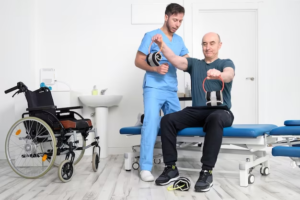Think about a treatment approach that combines ancient knowledge with cutting-edge science to provide relief from a wide range of symptoms and a road map to improved health. One possible approach to achieving this goal is to engage in dynamic cupping therapy, an age-old healing practice that has recently seen a resurgence in popularity. In order to provide a thorough examination of dynamic cupping therapy, this article will cover its origins, the numerous techniques used, the potential therapeutic benefits, and the most often asked questions. The goal is better understanding and more efficient application of this treatment method.
Understanding Dynamic Cupping Therapy
Cupping treatment, or dynamic cupping therapy, is an old kind of alternative medicine that has its roots in the cultures of ancient China, Egypt, and the Middle East. Special cups are used to create a vacuum-like suction effect on the skin. By boosting the body’s natural energy flow, this subtle yet deep technique increases circulation, reduces stress, and has a therapeutic effect.
Modern practitioners of dynamic cupping therapy use a wide range of cupping techniques and implements to address a wide range of health issues. Moving the cups across the skin to create a dynamic and therapeutic impact is the basis of dynamic cupping, one of the most popular forms of cupping therapy.
The Mechanics of Dynamic Cupping
By lifting and separating tissues, improving circulation and inducing a state of deep relaxation, dynamic cupping therapy is based on the principles of negative pressure. This is how it functions:
- Preparation: Massage oil or lotion will be used as a lubricant by the therapist to reduce friction and facilitate easy cup movement.
- Cup Placement: Glass, silicone, or plastic cups are used to create a vacuum on the skin’s surface. Using either heat, mechanical pumps, or manual suction, a vacuum is created inside the cups.
- Movement: In dynamic cupping, the therapist moves the cups around the treatment region, as opposed to in static cupping, in which the cups remain in one place during the session. Gliding, twisting, and pumping are all examples of this type of motion.
- Duration: The therapist will adapt the cupping session to the patient’s needs and response. The average length of a session is between 10 and 30 minutes.
- Removal: Discoloration, or “cupping marks,” may appear on the patient’s skin when the therapist removes the cups during a dynamic cupping session; this is a normal side effect of the therapy and indicates improved blood flow and healing.
Benefits of Dynamic Cupping Therapy
The potential health benefits of dynamic cupping therapy are numerous and varied. Whether your goal is to reduce pain, increase circulation, or simply unwind, this therapy can help you achieve your goals.
- Pain Relief: Pain relief by dynamic cupping can range from muscular tension to joint pain to headaches. It helps alleviate pain by boosting circulation and relaxing tense muscles.
- Improved Circulation: Increased blood and lymphatic flow are among the benefits of cupping therapy, thanks to the suction impact. This may help the body recover itself more quickly and reduce inflammation.
- Stress Reduction: Inducing profound relaxation, dynamic cupping is a great option for stress reduction. The nervous system is calmed by the light stretching of the skin and underlying tissues, which induces a state of deep relaxation.
- Detoxification: The stimulation of lymphatic drainage brought about by cupping is thought to aid in the elimination of metabolic waste and pollutants. The general health may benefit from this cleansing impact.
- Muscle Recovery: Dynamic cupping therapy is frequently used by athletes to speed up muscle recovery and lessen post-workout discomfort. Muscle healing is aided by the raised blood pressure and tissue mobility.
- Respiratory Health: Asthma and bronchitis sufferers are among those who can benefit from a cupping treatment. It can relieve congestion and enhance lung function by activating the chest and back.
- Skin Rejuvenation: It’s possible that dynamic cupping therapy can increase collagen formation and make the skin look better. Scars and cellulite can occasionally be improved with its help when applied topically.
- Enhanced Energy Flow: Cupping is used in traditional Chinese medicine to restore the body’s qi equilibrium. Achieving this equilibrium may improve one’s health and vigor.
Conditions Treated with Dynamic Cupping Therapy
Dynamic cupping therapy can be used to treat a variety of health issues, both physiological and psychological. Among the many medical issues that can be helped by dynamic cupping are:
| Condition | Description |
| Back Pain | In order to alleviate back pain, dynamic cupping is highly beneficial since it increases local blood flow, calms tense muscles, and decreases inflammation. Muscle strains, herniated discs, and general pain are just some of the problems that can benefit from this treatment. |
| Neck and Shoulder Tension | Cupping therapy is effective for relieving stress in the back, neck, and shoulders. Tense muscles are released, range of motion is increased, and pain associated with stiff neck and poor posture is reduced because to the suction caused by the cups. |
| Migraines and Headaches | Migraine and tension headache sufferers may find relief through dynamic cupping. The increased blood flow to the head and neck can help alleviate headache pain and help you unwind. |
| Arthritis and Fibromyalgia | Arthritis and fibromyalgia sufferers can benefit from cupping therapy for the relief of joint pain and muscle stiffness. It improves blood flow, relaxes muscles, and temporarily relieves chronic pain. |
| Anxiety and Stress-Related Disorders | Because of its sedative effects on the central nervous system, dynamic cupping is a useful supplemental treatment for those who suffer from stress, anxiety, and emotional strain. |
| Digestive Issues | The abdominal area may receive more blood flow through cupping, which, in turn, may promote relaxation of the digestive organs and improve digestion. Individuals suffering from Irritable Bowel Syndrome (IBS) or indigestion may reap the benefits of this treatment. |
| Insomnia | Some people who suffer from sleeplessness find that cupping therapy helps them relax. By lowering tension and anxiety, it can help you get a better night’s sleep. |
| Sports Injuries | Dynamic cupping is frequently used by athletes because of its ability to hasten the recovery from sports-related injuries. It’s beneficial for decreasing swelling, boosting blood flow, and relieving muscle pain. |
| Respiratory Conditions | Asthma and bronchitis are respiratory illnesses that may benefit from cup therapy. It can help those who are having trouble breathing by improving lung function and decreasing chest congestion. |
Dynamic Cupping Techniques

Dynamic cupping encompasses several techniques that cater to specific needs and conditions. Here are some of the most commonly used dynamic cupping techniques:
- Glide Cupping: The therapist applies lubrication to the skin and moves the cups smoothly across the treatment area. This technique is effective for pain relief, muscle tension, and relaxation.
- Pump Cupping: In pump cupping, the therapist repeatedly removes and reapplies the cups, creating a gentle pulsation. This technique is beneficial for lymphatic drainage and detoxification.
- Flash Cupping: Flash cupping involves quickly applying and removing cups to stimulate blood flow and alleviate pain. It is often used for acute conditions and trigger point release.
- Swivel Cupping: Swivel cupping combines rotation and gliding movements to target specific muscle groups. It is effective for increasing range of motion and addressing muscle imbalances.
- Fire Cupping: In traditional fire cupping, a flame is briefly introduced into the cup to create suction before placing it on the skin. Fire cupping is known for its strong suction and deep tissue effect.
- Facial Cupping: Facial cupping utilizes smaller cups to enhance circulation and tone facial muscles, promoting a youthful complexion.
Conclusion
Dynamic cupping therapy is a time-tested healing modality that offers a myriad of benefits for physical and emotional well-being. By enhancing circulation, reducing pain, and promoting relaxation, dynamic cupping can play a valuable role in your holistic healthcare routine. Whether you seek relief from pain or simply want to improve your overall wellness, consider exploring the world of dynamic cupping therapy to unlock its healing potential. With its rich history and modern applications, dynamic cupping therapy stands as a dynamic force in the world of holistic healing.
FAQs
Is dynamic cupping therapy painful?
No, dynamic cupping therapy should not be painful. Patients may experience some discomfort initially due to the suction, but it should not be painful. The sensation is typically described as a pulling or stretching feeling.
Are cupping marks permanent?
Cupping marks, also known as petechiae, are temporary and usually fade within a few days to a week. They are a sign of increased circulation and healing.
How many sessions of dynamic cupping are needed for results?
The number of sessions required varies depending on the individual and their specific condition. Some people experience immediate relief, while others may require multiple sessions for long-term benefits.
Is dynamic cupping therapy safe for everyone?
Dynamic cupping therapy is generally safe for most people. However, individuals with certain medical conditions, such as hemophilia or skin infections, should consult with a healthcare provider before undergoing cupping therapy.
Can I perform cupping at home?
While it is possible to purchase cupping sets for home use, it is recommended to seek the expertise of a trained therapist for optimal results and safety.











+ There are no comments
Add yours